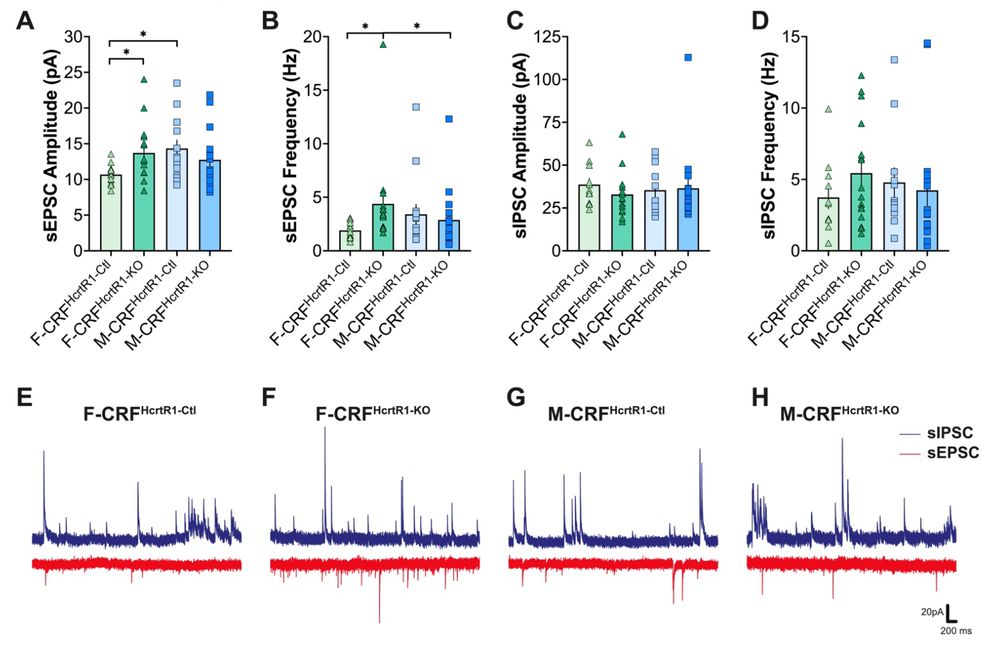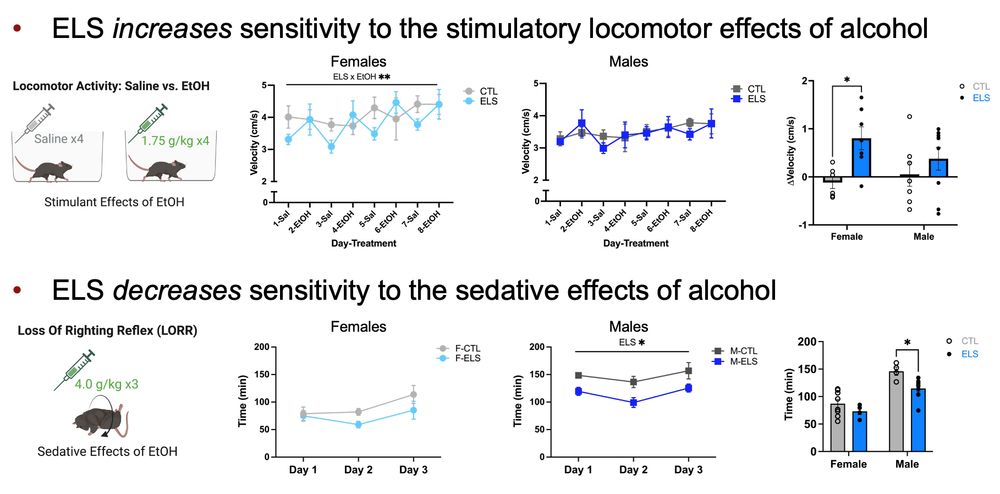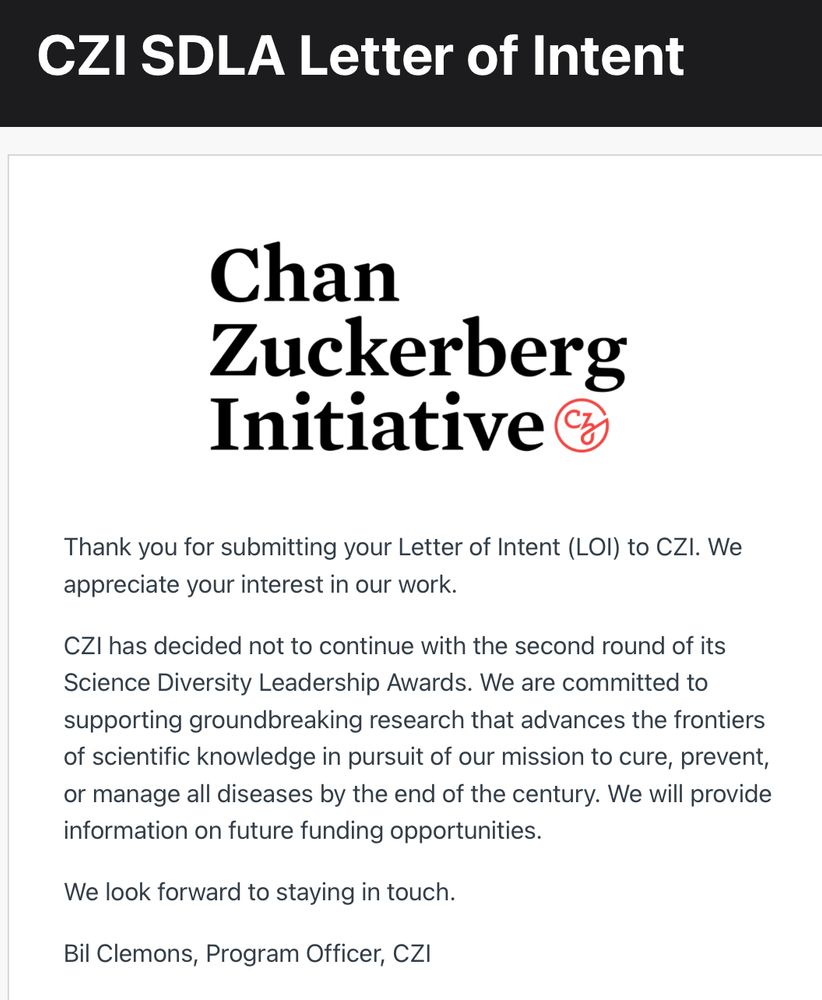
Will Giardino
@willgiardino.bsky.social
Neuroscientist, Assistant Professor @ Stanford, PI @ Giardino Lab. Personal account, personal views.
Pinned

Excited to share new research from my lab in final published form! By deleting hypocretin (orexin) receptors from CRF neurons, we uncovered neuropeptide mechanisms linking alcohol drinking and negative emotional hyperarousal through BNST neuronal excitability.
www.sciencedirect.com/science/arti...
www.sciencedirect.com/science/arti...
New preprint from the lab! We identified Vipr2-expressing BNST neurons as a distinct subpopulation of the oval nucleus that promotes feeding, is activated by food restriction, is non-overlapping with appetite-suppressing PKC delta neurons, and projects to PSTN & PVN hypothalamic feeding centers.

November 11, 2025 at 4:39 PM
New preprint from the lab! We identified Vipr2-expressing BNST neurons as a distinct subpopulation of the oval nucleus that promotes feeding, is activated by food restriction, is non-overlapping with appetite-suppressing PKC delta neurons, and projects to PSTN & PVN hypothalamic feeding centers.
Reposted by Will Giardino
A Distinct Subpopulation of Extended Amygdala Neurons Drives Food Intake https://www.biorxiv.org/content/10.1101/2025.11.07.685941v1
November 10, 2025 at 7:16 PM
A Distinct Subpopulation of Extended Amygdala Neurons Drives Food Intake https://www.biorxiv.org/content/10.1101/2025.11.07.685941v1
Excited to share new research from my lab in final published form! By deleting hypocretin (orexin) receptors from CRF neurons, we uncovered neuropeptide mechanisms linking alcohol drinking and negative emotional hyperarousal through BNST neuronal excitability.
www.sciencedirect.com/science/arti...
www.sciencedirect.com/science/arti...

November 3, 2025 at 5:19 PM
Excited to share new research from my lab in final published form! By deleting hypocretin (orexin) receptors from CRF neurons, we uncovered neuropeptide mechanisms linking alcohol drinking and negative emotional hyperarousal through BNST neuronal excitability.
www.sciencedirect.com/science/arti...
www.sciencedirect.com/science/arti...
Reposted by Will Giardino
🚨 Please RT!
We’re recruiting a motivated postdoc to dissect the neurocircuits of affective pain.
Expertise in behavioral models of pain/SUDs, stereotaxy, microscopy, opto/chemogenetics, or fiber photometry encouraged.
Apply 👉 recruit.apo.ucla.edu/JPF10647
#Neuroscience #Postdoc
We’re recruiting a motivated postdoc to dissect the neurocircuits of affective pain.
Expertise in behavioral models of pain/SUDs, stereotaxy, microscopy, opto/chemogenetics, or fiber photometry encouraged.
Apply 👉 recruit.apo.ucla.edu/JPF10647
#Neuroscience #Postdoc

Postdoctoral Research Position
University of California, Los Angeles is hiring. Apply now!
recruit.apo.ucla.edu
October 21, 2025 at 11:44 PM
🚨 Please RT!
We’re recruiting a motivated postdoc to dissect the neurocircuits of affective pain.
Expertise in behavioral models of pain/SUDs, stereotaxy, microscopy, opto/chemogenetics, or fiber photometry encouraged.
Apply 👉 recruit.apo.ucla.edu/JPF10647
#Neuroscience #Postdoc
We’re recruiting a motivated postdoc to dissect the neurocircuits of affective pain.
Expertise in behavioral models of pain/SUDs, stereotaxy, microscopy, opto/chemogenetics, or fiber photometry encouraged.
Apply 👉 recruit.apo.ucla.edu/JPF10647
#Neuroscience #Postdoc
Reposted by Will Giardino
Reposted by Will Giardino
Our work on mind-boggling CRF-BNST neurons is out! 🥳
🔹Sex & estrous matter: CRF neurons⬇️anxious arousal (yup) after unpredictable fear in diestrus👧not👦
🔹👧show⬆️contextual fear, independent of CRF/estrous
✨Anxiety-potentiated startle🟰👍 readout in🚶♀️&🐀
www.biologicalpsychiatryjournal.com/article/S000...
🔹Sex & estrous matter: CRF neurons⬇️anxious arousal (yup) after unpredictable fear in diestrus👧not👦
🔹👧show⬆️contextual fear, independent of CRF/estrous
✨Anxiety-potentiated startle🟰👍 readout in🚶♀️&🐀
www.biologicalpsychiatryjournal.com/article/S000...

Activity of corticotropin-releasing factor neurons in the bed nucleus of the stria terminalis reduces anxiety-potentiated startle in female rats in an estrous phase-dependent manner
The prevalence of post-traumatic stress disorder (PTSD) and anxiety disorders is higher
in women than men. The severity of hallmark symptoms including hypervigilance and
fear reactivity to unpredictab...
www.biologicalpsychiatryjournal.com
September 26, 2025 at 7:28 PM
Our work on mind-boggling CRF-BNST neurons is out! 🥳
🔹Sex & estrous matter: CRF neurons⬇️anxious arousal (yup) after unpredictable fear in diestrus👧not👦
🔹👧show⬆️contextual fear, independent of CRF/estrous
✨Anxiety-potentiated startle🟰👍 readout in🚶♀️&🐀
www.biologicalpsychiatryjournal.com/article/S000...
🔹Sex & estrous matter: CRF neurons⬇️anxious arousal (yup) after unpredictable fear in diestrus👧not👦
🔹👧show⬆️contextual fear, independent of CRF/estrous
✨Anxiety-potentiated startle🟰👍 readout in🚶♀️&🐀
www.biologicalpsychiatryjournal.com/article/S000...
Reposted by Will Giardino
Excited to share our new preprint!
www.biorxiv.org/content/10.1...
Divergent modulation of dopaminergic neurons by hypocretin/orexin receptors-1 and -2 shapes dopaminergic cell activity and socio-emotional behavior
Tzanoulinou et al
Supported by @snsf.ch
www.biorxiv.org/content/10.1...
Divergent modulation of dopaminergic neurons by hypocretin/orexin receptors-1 and -2 shapes dopaminergic cell activity and socio-emotional behavior
Tzanoulinou et al
Supported by @snsf.ch

July 25, 2025 at 4:06 PM
Excited to share our new preprint!
www.biorxiv.org/content/10.1...
Divergent modulation of dopaminergic neurons by hypocretin/orexin receptors-1 and -2 shapes dopaminergic cell activity and socio-emotional behavior
Tzanoulinou et al
Supported by @snsf.ch
www.biorxiv.org/content/10.1...
Divergent modulation of dopaminergic neurons by hypocretin/orexin receptors-1 and -2 shapes dopaminergic cell activity and socio-emotional behavior
Tzanoulinou et al
Supported by @snsf.ch
We’re excited to share our new preprint from the lab! PhD student @armorningstar.bsky.social demonstrated how Early Life Stress shapes sex-specific vulnerability to alcohol behavioral sensitivity, alcohol drinking, and alcohol's effects on social behaviors in mice.

July 7, 2025 at 5:14 PM
We’re excited to share our new preprint from the lab! PhD student @armorningstar.bsky.social demonstrated how Early Life Stress shapes sex-specific vulnerability to alcohol behavioral sensitivity, alcohol drinking, and alcohol's effects on social behaviors in mice.
Reposted by Will Giardino
Early life stress modulates behavioral sensitivity to alcohol and promotes escalation of alcohol drinking https://www.biorxiv.org/content/10.1101/2025.06.27.661986v1
June 28, 2025 at 11:16 PM
Early life stress modulates behavioral sensitivity to alcohol and promotes escalation of alcohol drinking https://www.biorxiv.org/content/10.1101/2025.06.27.661986v1
Honored to give a seminar at NIH/NIDA IRP in Baltimore this week and learn about the incredible research being done there by so many brilliant, diverse people to advance neuroscience and addiction treatment. Immense respect for all the NIH scientists & staff, working under such unfair circumstances


May 14, 2025 at 3:53 PM
Honored to give a seminar at NIH/NIDA IRP in Baltimore this week and learn about the incredible research being done there by so many brilliant, diverse people to advance neuroscience and addiction treatment. Immense respect for all the NIH scientists & staff, working under such unfair circumstances
Reposted by Will Giardino
new paper out in Transcranial Magnetic Stimulation: a ‘reverse translational‘ model of TMS for Alcohol Use Disorder — we know so little about which TMS parameters will be best to reduce drinking — so, why not leverage mice to test things out rapidly & cheaply? www.sciencedirect.com/science/arti...

Developing a reverse translational model of low-intensity rTMS in alcohol use disorder: The influence of theta burst stimulation protocols on binge alcohol drinking in mice
Repetitive Transcranial Magnetic Stimulation (rTMS) is a promising treatment tool for Alcohol Use Disorder (AUD). A challenge facing the field is that…
www.sciencedirect.com
April 29, 2025 at 12:16 AM
new paper out in Transcranial Magnetic Stimulation: a ‘reverse translational‘ model of TMS for Alcohol Use Disorder — we know so little about which TMS parameters will be best to reduce drinking — so, why not leverage mice to test things out rapidly & cheaply? www.sciencedirect.com/science/arti...
Thrilled to contribute to this collaboration with the McNerney lab, @danmccalley.bsky.social, Claudia Padula, and team - where we used distinct TMS neuromodulation protocols to observe sex-specific impacts on binge alcohol drinking in mice! #TranscranialMagneticStimulation
new paper out in Transcranial Magnetic Stimulation: a ‘reverse translational‘ model of TMS for Alcohol Use Disorder — we know so little about which TMS parameters will be best to reduce drinking — so, why not leverage mice to test things out rapidly & cheaply? www.sciencedirect.com/science/arti...

Developing a reverse translational model of low-intensity rTMS in alcohol use disorder: The influence of theta burst stimulation protocols on binge alcohol drinking in mice
Repetitive Transcranial Magnetic Stimulation (rTMS) is a promising treatment tool for Alcohol Use Disorder (AUD). A challenge facing the field is that…
www.sciencedirect.com
April 29, 2025 at 3:47 PM
Thrilled to contribute to this collaboration with the McNerney lab, @danmccalley.bsky.social, Claudia Padula, and team - where we used distinct TMS neuromodulation protocols to observe sex-specific impacts on binge alcohol drinking in mice! #TranscranialMagneticStimulation
Reposted by Will Giardino
Check out our new paper lead by superstars Amy Pearl and Xavier Maddern in @naturecomms.bsky.social . We show a sex specific role for ghrelin signalling in the Edinger Westphal nucleus driving binge drinking. Thanks to all those involved www.nature.com/articles/s41...

Midbrain ghrelin receptor signalling regulates binge drinking in a sex specific manner - Nature Communications
Binge drinking is a rising issue in women, yet the underlying neurobiology remains underexplored. Here authors show the Edinger-Westphal (EWcp) peptidergic neurons as a critical regulator of binge dri...
www.nature.com
March 21, 2025 at 5:46 AM
Check out our new paper lead by superstars Amy Pearl and Xavier Maddern in @naturecomms.bsky.social . We show a sex specific role for ghrelin signalling in the Edinger Westphal nucleus driving binge drinking. Thanks to all those involved www.nature.com/articles/s41...
So proud of the Giardino lab members #StandUpForScience @standupforscience.bsky.social

March 8, 2025 at 3:10 AM
So proud of the Giardino lab members #StandUpForScience @standupforscience.bsky.social
an excellent interview with an excellent science friend!
Our next profile is here! Dr. Monique Smith (@moeneuro.bsky.social) studies the neural mechanisms of empathy. Follow the link below to learn more!
www.storiesofwin.org/profiles/202...
#StoriesOfWiN #WomenInNeuroscience
www.storiesofwin.org/profiles/202...
#StoriesOfWiN #WomenInNeuroscience

Dr. Monique Smith — Stories of WiN
studies the neural mechanisms of empathy
www.storiesofwin.org
March 6, 2025 at 7:28 AM
an excellent interview with an excellent science friend!
Reposted by Will Giardino
𝗪𝗵𝘆 𝗱𝗼 𝗮𝗻𝗲𝘀𝘁𝗵𝗲𝘁𝗶𝗰𝘀 𝗵𝗮𝘃𝗲 𝗮𝗻𝘅𝗶𝗼𝗹𝗶𝘁𝗶𝗰 𝗲𝗳𝗳𝗲𝗰𝘁𝘀?
One reason might be that the bed nucleus of the stria terminalis suppresses anxiety.
(Btw this region is as important as the amygdala in anxiety, likely more).
(h/t @ajshackman.bsky.social)
#neuroscience #neuroskyence
doi.org/10.1016/j.ce...
One reason might be that the bed nucleus of the stria terminalis suppresses anxiety.
(Btw this region is as important as the amygdala in anxiety, likely more).
(h/t @ajshackman.bsky.social)
#neuroscience #neuroskyence
doi.org/10.1016/j.ce...

March 4, 2025 at 5:02 PM
𝗪𝗵𝘆 𝗱𝗼 𝗮𝗻𝗲𝘀𝘁𝗵𝗲𝘁𝗶𝗰𝘀 𝗵𝗮𝘃𝗲 𝗮𝗻𝘅𝗶𝗼𝗹𝗶𝘁𝗶𝗰 𝗲𝗳𝗳𝗲𝗰𝘁𝘀?
One reason might be that the bed nucleus of the stria terminalis suppresses anxiety.
(Btw this region is as important as the amygdala in anxiety, likely more).
(h/t @ajshackman.bsky.social)
#neuroscience #neuroskyence
doi.org/10.1016/j.ce...
One reason might be that the bed nucleus of the stria terminalis suppresses anxiety.
(Btw this region is as important as the amygdala in anxiety, likely more).
(h/t @ajshackman.bsky.social)
#neuroscience #neuroskyence
doi.org/10.1016/j.ce...
Reposted by Will Giardino
Recruiting a postdoc! State-dependent regulation of social behavior & social group dynamics using in vivo deep brain calcium imaging, machine learning, etc... all the circuit tools. Applicants can email me directly if interested and apply here: academicjobsonline.org/ajo/jobs/29799.
Duke University, Psychology and Neuroscience
Job #AJO29799, Postdoctoral Associate, Psychology and Neuroscience, Duke University, Durham, North Carolina, US
academicjobsonline.org
February 28, 2025 at 5:04 PM
Recruiting a postdoc! State-dependent regulation of social behavior & social group dynamics using in vivo deep brain calcium imaging, machine learning, etc... all the circuit tools. Applicants can email me directly if interested and apply here: academicjobsonline.org/ajo/jobs/29799.
Reposted by Will Giardino
My heart breaks daily for those who started careers in the pandemic & survived 5 years of heart wrenching loss and uncertainty to now be faced with loss and uncertainty. This time, the uncertainty is driven by pure evil and is 💯 unnecessary. That's why we must all @standupforscience.bsky.social
Graduating during the pandemic slowed down my process and is part of why I did two postdocs. Now as a first year faculty, all the federal grants are frozen. I love the work I do but this has all of us questioning how much www.science.org/content/arti...

U.S. early-career researchers struggling amid chaos
Uncertain funding, government firings, and distressed universities hit vulnerable groups especially hard
www.science.org
February 25, 2025 at 12:36 AM
My heart breaks daily for those who started careers in the pandemic & survived 5 years of heart wrenching loss and uncertainty to now be faced with loss and uncertainty. This time, the uncertainty is driven by pure evil and is 💯 unnecessary. That's why we must all @standupforscience.bsky.social
Reposted by Will Giardino
First they came for my diversity grant, and I did not freak out - because I still had an R01. Then they paused federal funding, and I did not freak out - because I had a start up package with central funds. Then they cut indirect costs, and there was no research program left to freak out over
February 12, 2025 at 1:35 PM
First they came for my diversity grant, and I did not freak out - because I still had an R01. Then they paused federal funding, and I did not freak out - because I had a start up package with central funds. Then they cut indirect costs, and there was no research program left to freak out over
Reposted by Will Giardino
There are a huge # of scientists who are rapidly reconsidering their futures right now, and their ability to move on careerwise might be contingent on a milestone (paper, committee approval) that you have a direct role in. One small way to help is to consider the impact of that responsibility.
February 12, 2025 at 4:44 PM
There are a huge # of scientists who are rapidly reconsidering their futures right now, and their ability to move on careerwise might be contingent on a milestone (paper, committee approval) that you have a direct role in. One small way to help is to consider the impact of that responsibility.
Reposted by Will Giardino
As a leader in my lab & various initiatives, I’ve made my stance clear....my commitment to DEI is unwavering. I won’t back down or shy away, even as others do. I’ll continue to uphold and advocate for these values.
February 12, 2025 at 5:54 PM
As a leader in my lab & various initiatives, I’ve made my stance clear....my commitment to DEI is unwavering. I won’t back down or shy away, even as others do. I’ll continue to uphold and advocate for these values.
For anyone who thinks that private philanthropy is going to step in and fill the void left by NIH, here's a preview of how that's going to work out: "Thank you for your recent application submission... We received 146 applications in total, about 3 times more than the previous year."
February 10, 2025 at 10:44 PM
For anyone who thinks that private philanthropy is going to step in and fill the void left by NIH, here's a preview of how that's going to work out: "Thank you for your recent application submission... We received 146 applications in total, about 3 times more than the previous year."
Reposted by Will Giardino
Open (public) sessions of NIDA and NIAAA Advisory council meetings scheduled for this week are both cancelled. Keep making calls folks.
nida.nih.gov/about-nida/a...
nida.nih.gov/about-nida/a...
National Advisory Council Agenda | National Institute on Drug Abuse
At the present time, all NIH public meetings are cancelled. We apologize for any inconvenience this may cause and appreciate your understanding.
nida.nih.gov
February 4, 2025 at 5:40 PM
Open (public) sessions of NIDA and NIAAA Advisory council meetings scheduled for this week are both cancelled. Keep making calls folks.
nida.nih.gov/about-nida/a...
nida.nih.gov/about-nida/a...
Reposted by Will Giardino
And lots of foundation grants state that no salary support is allowed. Many folks don't understand that faculty (often at med schools) are often on "soft money" meaning we pay our own salary out of our federal grants.
Yep. For example, my lab currently runs on 2 NIH R01s and a foundation grant. While I am eternally grateful for the MDA grant, it is ~12% of the money coming into my lab. It is enough to pay 1 person. I'm only allowed to put 15% of my own salary off that grant, but I need to cover 60% of my salary
This a funding myth.
There are no untapped wells of charity money that can support the kind of research biomedical scientists need to perform today. Most foundation grants are in 25 to 75K/year range, many are on the order of 1-3 years, and in spite of this, are highly competitive.
There are no untapped wells of charity money that can support the kind of research biomedical scientists need to perform today. Most foundation grants are in 25 to 75K/year range, many are on the order of 1-3 years, and in spite of this, are highly competitive.
February 5, 2025 at 12:46 PM
And lots of foundation grants state that no salary support is allowed. Many folks don't understand that faculty (often at med schools) are often on "soft money" meaning we pay our own salary out of our federal grants.



